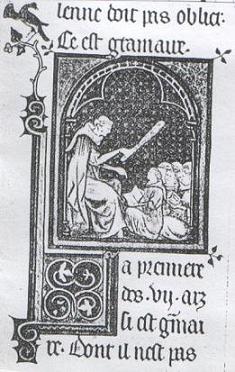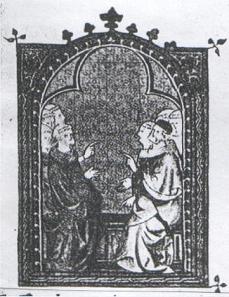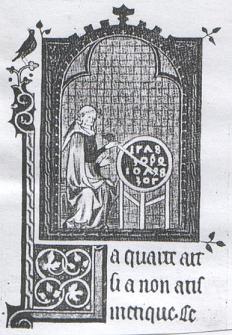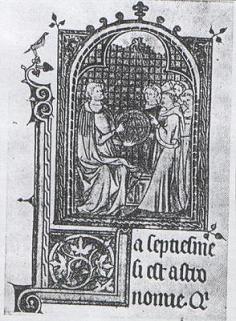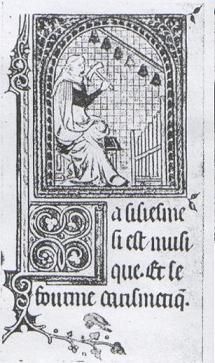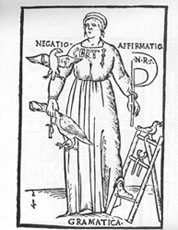
A standard of cruelty to which one must never aspire
Welcome to the first set of notes for this class. Notes will generally consist of:
- a synopsis of what was covered: synopsis, key terms and concepts
- a list of references, as far as possible with links: either to the things themselves (manuscripts, images of objects, art-works) or to something about them (often Wikipedia)
NB: you are NOT expected to read all of the extra references: neither straight after class, nor at any point during the course. And I will never ask you if you have done so!
They may be helpful to you for remembering what we did in class, or as a supplement to your own notes.
They might also be helpful as resources for your liberal art’s week’s work, or for the midterm commentary or your final project.
I am not that cruel…
That is all!
WEEK 1
THURSDAY
- Introduction
WEEK 2
TUESDAY
- Whistle-stop tour of a brief history of time (5th-14th centuries), viewed through the lens of the manuscript tradition of Martianus Capella’s De nuptiis Philologiae et Mercurii
Links from lecture & bonus extra links
(NB: FOR INFORMATION ONLY: you are NOT expected to read all of these! Neither this week nor any other.):
- Google image search
- Schoenberg manuscript database search > Martianus Capella: 163 mss, some containing just “our” text, most containing excerpts; the idea of books as compilations, a flexible living changing moving text, to which readers (selecting, compiling, editing, commenting, etc.) contribute
- Huygens Institute > Carolingian scholarship > glosses on Martianus Capella: “This website contains the edition of the oldest gloss-tradition on Martianus Capella’s De nuptiis Philologiae et Mercurii, based on the ninth-century manuscript Leiden, UB, Vossianus Latinus Folio 48. The photos and edition of text and gloss material of this manuscript are found in the folder Manuscript photos and edition.”
- Another example of our text + (integrated) gloss & commentary (Remigius of Auxerre, 11th c.)
- Meet the Parker Library On The Web (Corpus Christi College, Cambridge; & Stanford):
—what an old-fashioned manuscript search looked like (this is the same M.R. James who wrote classic ghost stories); and more;
—Parker 330: a Martianus Capella with glosses in Welsh, evidence for language-learning in action (learning Latin, here; and leaving helpful notes for the benefit of future readers): description, digitised manuscript - And a third example of a commentated Martianus Capella that’s also a compendium: here, British Library Harley MS 2510 (+ Cicero, Boethius, & commentary: Thierry of Chartres (12th c.))
(Footnote: 12th-c. cathedrals will return (Chartres, Paris, etc.); Chartres and its cathedral school is the principal intellectual centre of France (and one of the main nodes in a whole European and international network) before the foundation and flourishing of the university of Paris. See also: Bernard of Chartres & Alain de Lille (12th c.), Chartrean Neoplatonism)
Exercise in reading:
- Notre-Dame (Cathedral of Our Lady), Paris.
- See also: Google image search, official website
- (footnote for future reference: websites are beautiful examples for reading-exercises, and for seeing the harmonious conjunction—or not—of the seven liberal arts, combined with practical arts such as architecture)
THURSDAY
Fieldwork-day on “your” liberal art:
- come to class, at the usual time and in the usual place
- using the attached list [on email sent to students by the FSC] of people and their groups, locate the other people in your group (there should be around 5 people per group). This would also be an opportunity to move around groups: I don’t mind, provided that no group has fewer than 3 people and provided that all concerned are agreeable to the moves
- for the next parts, you may choose to stay in the classroom to work, or go elsewhere:
—find at least one medieval representation of your liberal art: for example via the Schoenberg manuscript database:
—locate your liberal art in The Marriage of Philology and Mercury (at your Connect site)
—and, as individual or group reading work, find what strike you (for whatever reason) as key or salient points. This could effectively be a summary or a commentary; working separately or together. It can of course be short. - final part:
—go to the library (mostly Koerner, the music group may find the Music library useful)
—locate as many areas as you can (thinking laterally is encouraged) where you would find further information about your liberal art. Prove you have physically been there (for example, take a group photo posing with a relevant work in the relevant area of the library). - When we reconvene on Tuesday, we will spend
the first half ofthe class less formally, on your findings. The end result will be that the whole class will have done a preliminary reading, together, of almost all of The Marriage of Philology and Mercury without breaking a heavy sweat. I will provide further images too.
- grammar
- logic/dialectic
- rhetoric
- arithmetic
- geometry
- astronomy
- music
Images above: via Karl Catteeuw, University of Leuven – Centre for the History of Education, 2003; on Donatus’s Grammar: quiz (in Dutch) on the liberal arts
